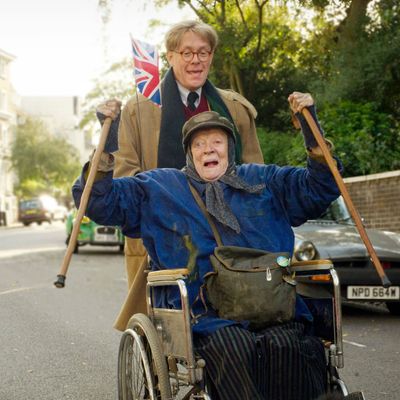
Nicholas Hytner’s twee film of Alan Bennett’s The Lady in the Van is the final injury to what was, in its original form, a perfect thing: Bennett’s diary entries recounting the appearance of the prodigiously unstable (and unhygienic) but proud “Miss Shepherd” in a broken-down van on his block and her move — at his meekly gallant invitation when she was forced off the public street — to park her vehicle and herself in his driveway. She remained there for 15 years.
Have you read said entries? Buy Bennett’s audio version and listen to him read in his faintly embarrassed tones, which are no less genuine for having been cultivated. Miss Shepherd exists in the margins of his life, someone he had to reckon seriously with only when she or some crisis in her increasingly enfeebled existence imposed on him. She was — despite some inquiries he made about her background — a mystery to the end. Even the inside of that van was off limits until they removed her body.
In his theatrical adaptation and now this screenplay, Bennett gives us not one but two Alan Bennetts, played onscreen by Alex Jennings with a high-tenor squeak just this side of Truman Capote and the sad frown of Stan Laurel. The gimmick is that one Bennett encourages the other to exploit Miss Shepherd (Maggie Smith) as fodder for a play or movie script and add events and interactions that never happened but would play well. The other Bennett worries that he’s exploiting her. He should have just used her — no shame, she was an exhibitionist and is dead now anyway — and gotten on with it. The two Bennetts double his tedious squeamishness, and scenes with his friends (“How’s your old lady?”) triple it. We already know how conflicted he is.
The film of The Lady in the Van becomes a journey in which Bennett pieces together the arc of Miss Shepherd’s life while tending to his own middle-class failing mother, who’s increasingly deluded but none too swift even with her full faculties. The inside of Miss Shepherd’s van — crammed with newspapers, street junk, and inorganic and organic filth — is visible every time she opens the back doors, which she does often. We watch her inside gazing at the telly. We see flashbacks to her younger self as a gifted pianist forced to give up music by repressive nuns. We follow her on a road trip. We find out that she had a tragic accident that drove her underground and that a sinister stranger (Jim Broadbent) comes by to see her on occasion.
The mystery is gone and so, frankly, is the thrill. But Maggie Smith does her best to give the role some edge. She is fiercely unlikable, demanding help rather than asking for it, and managing to look scary rather than cute in a wheelchair flying the Union Jack. One scene reminds you of her greatness. On that road trip, Miss Shepherd wanders into a senior-citizens’ center and watches a young woman play the piano. The mask of distaste dissolves before your eyes and you see the tragedy of her life.
Not everyone recoils from The Lady in the Van the way I do. It apparently plays well with older audiences and some critics praise its abiding sweetness. My adoration for Bennett’s published diaries doubtless colors my belief that, as a playwright and screenwriter, he went astray. I don’t think he dramatized this blessed accident in his life. I think he worried it to death.


